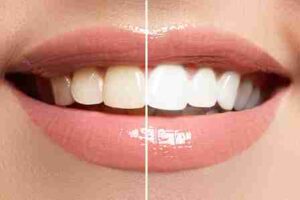Most of us have glanced at our teeth and wished they looked a little brighter. Over time, that natural sparkle tends to fade. It’s not just about appearances, teeth discolouration can affect your confidence and how you feel every day. But what actually causes teeth to lose their brightness, and how do whitening treatments tackle these stubborn stains? Let’s chat through the science and myths around discolouration, so you get the clearest picture of what’s happening beneath the surface.
Why Teeth Change Colour: More Than Just Stains
The Enamel-Dentin Connection
Teeth aren’t just white they have layers. The outer shell, enamel, is translucent. Beneath that lies dentin, a yellowish layer that naturally shows through if enamel thins. So sometimes, teeth look discoloured simply because the enamel wears away, revealing more dentin underneath. This is why ageing can make teeth appear yellower even without any staining substances.
Micro-Porosity and Stain Absorption
Tooth enamel is slightly porous at a microscopic level. This means it can absorb colour molecules from food and drink over time. The rougher or more worn your enamel is, the easier it is for these pigments to settle in almost like a sponge soaking up coffee or tea stains.
Biological Factors at Play
Your saliva, which helps keep your mouth clean, varies from person to person in composition and flow rate. Less saliva or a more acidic mouth environment encourages staining because teeth can’t self-clean as well. Even genetics play a role; some people naturally have thicker enamel or a whiter dentin shade.
Unique Causes of Discolouration You Might Not Know
Environmental Influences Beyond Diet
Pollution and environmental toxins can impact tooth colour subtly. For example, exposure to high levels of fluoride during childhood may cause a condition called fluorosis, leading to white or brown spots on teeth. Similarly, heavy metals like iron or copper in drinking water can sometimes cause unusual staining.
Medications and Medical Treatments
Certain medications cause tooth discolouration in unexpected ways. Beyond antibiotics like tetracycline, antihistamines, blood pressure meds, and chemotherapy agents can all influence tooth colour over time. It’s a less commonly discussed cause but important to consider if you’ve noticed a gradual darkening.
Trauma’s Lasting Impression
Dental injuries don’t just hurt at the moment they can cause internal changes leading to discolouration months or years later. For example, a knocked-out tooth may lose vitality, darken, or develop greyish shades, requiring specific dental treatments rather than surface whitening.
How Professional Teeth Whitening Tackles Discolouration
Beyond the Surface: Breaking Down the Chemistry
Professional Teeth whitening Barnsley treatments don’t just mask stains; they break down the molecules causing discolouration. Peroxide molecules penetrate enamel and dentin, oxidising pigment molecules and rendering them colourless. This chemical reaction is precise and controlled by trained professionals to avoid damaging your teeth.
Personalised Treatment Plans
No two smiles are the same. A good whitening treatment isn’t “one size fits all.” Dentists assess your tooth structure, stain type, and sensitivity before recommending a tailored approach. This might include combining whitening with enamel strengthening treatments or special aftercare to maximise results.
Sensitivity Management is Key
Some whitening treatments can cause temporary sensitivity. Professionals are careful to manage this by adjusting peroxide concentrations and offering products with desensitisers. This personalised care helps avoid discomfort while achieving the desired brightness.

Lesser-Known Benefits of Teeth Whitening
Psychological Boost Beyond Aesthetics
Research shows a whiter smile can enhance self-esteem and even social perceptions. People tend to associate bright teeth with health, vitality, and youthfulness. Whitening can therefore provide a genuine confidence boost that affects personal and professional interactions positively.
Oral Hygiene Motivation
Many patients report improved oral hygiene habits after whitening treatments. The investment in their smile encourages them to maintain better brushing and flossing routines, which benefits overall dental health long-term.
Enhancing the Effect of Other Cosmetic Treatments
Whitening teeth can complement other dental procedures, such as veneers, crowns, or orthodontics. Matching the shade of restorations to a newly whitened natural smile creates a more harmonious, natural-looking result.
Common Myths Debunked
Whitening is Just Cosmetic — Not True
While aesthetics are a big part, whitening can also serve as an indicator of overall oral health. A dentist will often identify and treat underlying issues such as enamel erosion, decay, or gum disease before proceeding with whitening.
Whitening Destroys Enamel — False When Done Correctly
Professionally administered whitening uses carefully balanced peroxide concentrations and application times, avoiding enamel damage. Problems only arise with overuse of DIY products or unregulated treatments.
DIY Whitening is as Effective as Professional Treatment — Not Exactly
Over-the-counter options may lighten surface stains but can’t address deeper or intrinsic discolouration effectively. Professional treatments are designed for long-lasting, noticeable change under supervision.
How to Care for Your Smile After Whitening
Avoid Stain-Causing Foods and Drinks Initially
Your enamel is more porous post-treatment, so limiting exposure to coffee, tea, red wine, and dark sauces for at least 48 hours can help lock in results.
Maintain Regular Dental Visits
Routine cleanings keep plaque and tartar from building up, reducing the chance of new staining.
Use Whitening Toothpastes as Maintenance
These can help maintain brightness by gently removing surface stains, though they shouldn’t replace professional treatments.
Keep Lifestyle Factors in Check
Smoking and poor oral hygiene dramatically shorten whitening effects, so cutting back or quitting smoking and maintaining good oral care is essential.

When to Consult a Professional
If you experience sudden tooth discolouration or pain, seeing an emergency dentist in Barnsley is crucial. Sometimes, underlying problems such as decay or trauma cause discolouration and require immediate attention rather than cosmetic whitening.For those considering whitening, a consultation with a teeth whitening expert ensures the treatment suits your individual needs and is done safely.
Conclusion
Teeth discolouration is a complex mix of biological, lifestyle, and environmental factors. Whitening treatments work by chemically breaking down stains in a safe, tailored way to restore your natural brightness. It’s not just about looks; a whiter smile can boost confidence and encourage better oral health habits. If you want professional advice or treatment, the team at EDB is here to guide you with care and expertise. Brightening your smile is a journey worth taking, with results that can truly make a difference in how you feel.